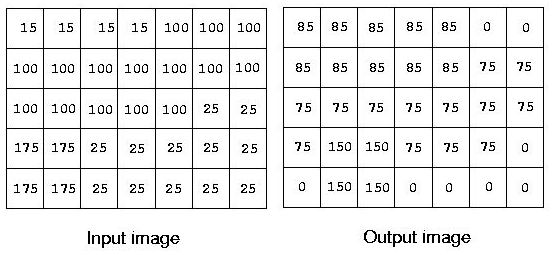Edge Detection
| Time Limit: 1000MS | Memory Limit: 10000K | |
| Total Submissions: 22153 | Accepted: 5201 |
Description
IONU Satellite Imaging, Inc. records and stores very large images using run length encoding. You are to write a program that reads a compressed image, finds the edges in the image, as described below, and outputs another compressed image of the detected edges.
A simple edge detection algorithm sets an output pixel's value to be the maximum absolute value of the differences between it and all its surrounding pixels in the input image. Consider the input image below:

The upper left pixel in the output image is the maximum of the values |15-15|,|15-100|, and |15-100|, which is 85. The pixel in the 4th row, 2nd column is computed as the maximum of |175-100|, |175-100|, |175-100|, |175-175|, |175-25|, |175-175|,|175-175|, and |175-25|, which is 150.
Images contain 2 to 1,000,000,000 (109) pixels. All images are encoded using run length encoding (RLE). This is a sequence of pairs, containing pixel value (0-255) and run length (1-109). Input images have at most 1,000 of these pairs. Successive pairs have different pixel values. All lines in an image contain the same number of pixels.
A simple edge detection algorithm sets an output pixel's value to be the maximum absolute value of the differences between it and all its surrounding pixels in the input image. Consider the input image below:

The upper left pixel in the output image is the maximum of the values |15-15|,|15-100|, and |15-100|, which is 85. The pixel in the 4th row, 2nd column is computed as the maximum of |175-100|, |175-100|, |175-100|, |175-175|, |175-25|, |175-175|,|175-175|, and |175-25|, which is 150.
Images contain 2 to 1,000,000,000 (109) pixels. All images are encoded using run length encoding (RLE). This is a sequence of pairs, containing pixel value (0-255) and run length (1-109). Input images have at most 1,000 of these pairs. Successive pairs have different pixel values. All lines in an image contain the same number of pixels.
Input
Input
consists of information for one or more images. Each image starts with
the width, in pixels, of each image line. This is followed by the RLE
pairs, one pair per line. A line with 0 0 indicates the end of the data
for that image. An image width of 0 indicates there are no more images
to process. The first image in the example input encodes the 5x7 input
image above.
Output
Output
is a series of edge-detected images, in the same format as the input
images, except that there may be more than 1,000 RLE pairs.
Sample Input
7 15 4 100 15 25 2 175 2 25 5 175 2 25 5 0 0 10 35 500000000 200 500000000 0 0 3 255 1 10 1 255 2 10 1 255 2 10 1 255 1 0 0 0
Sample Output
7 85 5 0 2 85 5 75 10 150 2 75 3 0 2 150 2 0 4 0 0 10 0 499999990 165 20 0 499999990 0 0 3 245 9 0 0 0
Hint
A brute force solution that attempts to compute an output value for every individual pixel will likely fail due to space or time constraints.
WARNING
说明:本程序不能在POJ上AC,并不是本程序有问题,而是POJ太不严谨(系统后台的测试数据绝对有问题!),能不能AC取决于测试数据的完备程度!要相信自己,不要过于相信平台!
随便给出一组测试数据:(从网上搜一个在POJ上AC的代码,用下组数据跑一下,绝对给你惊喜!错误的程序竟然能在POJ上AC,不是你的眼睛看错了,而是POJ的测试数据有问题,太水!)
5
6 4
7 5
9 11
0 0
0
源码如下:本程序虽然不能在POJ上AC,但不是本程序的问题,经过多次反复测试,本程序均能得到正确的结果!不多说了,自己看一下,跑一下,才能明白生活中很多坑!
参考:http://blog.csdn.net/v5zsq/article/details/46562881#cpp
1 #include<iostream> 2 #include<fstream> 3 #include<string> 4 //#include<cmath> 5 #include<algorithm> 6 using namespace std; 7 //pl对的个数,题目中明确表示不会超过1000个,只要设置大于1000即可 8 const int pl=1002; 9 /* 10 说明:1.对于一副图片来说,第一行输入是图片的宽度,理解为一行有多少个像素 11 2.之后每行输入两个整数,表示像素的连续段,第一个整数是连续段起始像素的值 12 第二整数表示该像素重复的次数,即连续段的长度 13 3.本程序中连续段描述为pl对,有n个连续段表示有n个pl对 14 */ 15 /* 16 mapin[][0] 表示当前pl对的像素值 17 mapin[][1] 表示当前pl对之前的所有pl对的长度和 18 可理解为,当前pl对应的连续段起始像素位置之前有多少个像素 19 */ 20 int mapin[1002][2]; 21 /* 22 width 图片的宽度,像素矩阵每行像素的数目 23 foot 图片的高度,像素矩阵一共有多少行 24 plzhi 每组测试用例中pl对的数目 25 sum 图片的像素数目 26 */ 27 int width,foot; 28 int plzhi; 29 int sum; 30 /* 31 pixInfo 输出数组的类型 32 loc 像素的位置 33 pix 该位置像素处理后的结果 34 mapout 输出数组 35 */ 36 struct pixInfo 37 { 38 int loc; 39 int pix; 40 }; 41 pixInfo mapout[pl*9]; 42 //根据位置,返回像素值 43 int locpix(int loc) 44 { 45 for(int i=plzhi-1;i>=0;i--) 46 if(loc>=mapin[i][1]) 47 return mapin[i][0]; 48 //return mapin[0][0]; 49 }; 50 //根据位置(用行和列表示),返回该位置像素处理后的结果 51 int result(int row,int col) 52 { 53 int pix=locpix(row*width+col);int value=0; 54 for(int i=row-1;i<=row+1;i++) 55 for(int j=col-1;j<=col+1;j++) 56 { 57 if(i<0||i>=foot||j<0||j>=width||(i==row&&j==col))//边界 58 continue; 59 if(abs(pix-locpix(i*width+j))>value) 60 value=abs(pix-locpix(i*width+j)); 61 } 62 return value; 63 }; 64 int cmp(pixInfo a,pixInfo b) 65 { 66 return a.loc<b.loc; 67 } 68 int main() 69 { 70 //ifstream in("test.txt"); 71 while(cin>>width&&width) 72 { 73 int pix,len;int k=0; 74 sum=0; 75 while(cin>>pix>>len&&len) 76 { mapin[k][0]=pix;mapin[k][1]=sum;sum+=len;k++; } 77 plzhi=k;//pl对,连续段的数目 78 mapin[plzhi][1]=sum;//输入数组的最后一个有效值 79 foot=sum/width;//输入像素矩阵的行数 80 int z=0;//记录输出数组mapout的长度 81 for(int p=0;p<k;p++)//k为pl对数目 82 { 83 //pl对起始位置像素 84 int row,col;//像素所处行和列 85 row=mapin[p][1]/width;col=mapin[p][1]%width; 86 //处理该像素及其相邻8个位置 87 for(int i=row-1;i<=row+1;i++) 88 for(int j=col-1;j<=col+1;j++) 89 { 90 if(i<0||i>=foot||j<0||j>=width)//边界 91 continue; 92 mapout[z].pix=result(i,j); 93 mapout[z].loc=i*width+j+1; 94 z++; 95 } 96 //如果当前连续段起始像素的位置不在每一行的开头,连续段又覆盖超过一行,处理下一行起始位置的像素 97 if(col&&(col+1+mapin[p+1][1]-mapin[p][1])>width)//处理下一行开始的位置 98 { 99 row=row+1;col=0; 100 //处理该像素及其相邻8个位置,共9个点 101 for(int i=row-1;i<=row+1;i++) 102 for(int j=col-1;j<=col+1;j++) 103 { 104 if(i<0||i>=foot||j<0||j>=width)//边界 105 continue; 106 mapout[z].pix=result(i,j); 107 mapout[z].loc=i*width+j+1; 108 z++; 109 } 110 } 111 } 112 sort(mapout,mapout+z,cmp); 113 cout<<width<<endl; 114 pixInfo fir=mapout[0]; 115 for(int m=0;m<z;m++) 116 { 117 if(fir.pix==mapout[m].pix) 118 continue; 119 cout<<fir.pix<<' '<<mapout[m].loc-fir.loc<<endl; 120 fir=mapout[m]; 121 } 122 cout<<mapout[m-1].pix<<' '<<sum-fir.loc+1<<endl; 123 cout<<'0'<<' '<<'0'<<endl; 124 } 125 cout<<'0'<<endl; 126 return 0; 127 }